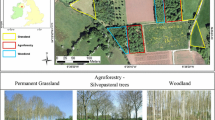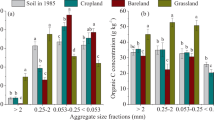Abstract
Background and Aims
Knowledge about the effect of land use change on soil organic carbon (OC) in semiarid grassland is essential for understanding C cycles and for forecasting ecosystem C sequestration. Our objectives were (1) to study the effect of land use change on aggregate size distribution, aggregate-associated OC concentrations, and aggregate-associated stocks in a semiarid grassland area and (2) to relate changes in the aggregate fractions to changes in total soil OC.
Methods
Cropland and shrubland plots were established in a semiarid grassland area in 1982. We collected soil samples from adjacent grassland, cropland, and shrubland plots 27 years later and measured OC concentrations in the macroaggregate (>0.25 mm), microaggregate (0.25–0.053 mm) and silt+clay (<0.053 mm) fractions.
Results
Total soil OC concentrations and stocks decreased significantly after the grassland was converted to cropland or shrubland. Soil microbial biomass C, root biomass, and root C also declined. The proportion of soil in the macroaggregate fraction decreased after conversion to cropland or shrubland. Decreases in macroaggregate-associated OC stocks accounted for more than half of the OC losses that occurred when grassland was converted to cropland. The decreases in macroaggregate-associated OC stocks were due to declines in both macroaggregation and macroaggregate-associated OC concentrations after conversion to cropland. In contrast, decreases in microaggregate-associated OC stocks accounted for more than half of the OC losses when grassland was converted to shrubland. The declines in microaggregate-associated OC stocks were primarily due to a decrease in microaggregate-associated OC concentrations after conversion to shrubland.
Conclusions
Land use changed caused significant decreases in soil OC stocks. Conversion to cropland soil resulted in large decreases in macroaggregate-associated OC stocks whereas conversion to shrubland resulted in large decreases in microaggregate-associated OC stocks. Any changes in land use in semiarid grasslands could cause the grassland soil to become a source of atmospheric CO2; therefore extreme caution should be taken to avoid this hazard.



Similar content being viewed by others
References
Archer S (1994) Woody plant encroachment into southwestern grasslands and savannas: rates, patterns and proximate causes. In: Vavra M, Laycock WA, Pieper RD (eds) Ecological implications of livestock herbivory in the West. Society for Range Management, Denver, pp 13–68
Ashagrie Y, Zech W, Guggenberger G (2005) Transformation of a Podocarpus falcatus dominated natural forest into a monoculture Eucalyptus globulus plantation at Munesa, Ethiopia: soil organic C, N and S dynamics in primary particle and aggregate-size fractions. Agric Ecosyst Environ 106:89–98
Ashagrie Y, Zech W, Guggenberger G, Mamo T (2007) Soil aggregation, and total and particulate organic matter following conversion of native forests to continuous cultivation in Ethiopia. Soil Till Res 94:101–108
Barthès B, Roose E (2002) Aggregate stability as an indicator of soil susceptibility to runoff and erosion; validation at several levels. Catena 47:133–149
Brookes PC, Landman A, Pruden G, Jenkinson DS (1985) Chloroform fumigation and the release of soil nitrogen, a rapid direct extraction method to measure microbial biomass nitrogen in soil. Soil Biol Biochem 17:837–842
Cambardella CA, Elliott ET (1993) Carbon and nitrogen distributions in aggregates from cultivated and grassland soils. Soil Sci Soc Am J 57:1071–1076
Ciais P, Soussana JF, Vuichard N, Luyssaert S, Don A, Janssens IA, Piao SL, Dechow R, Lathlére J, Maignan F, Wattenbach M, Smith P, Ammann C, Freibauer A, Schulze ED (2010) The greenhouse gas balance of European grasslands. Biogeosciences Discussions 7:5997–6050
Don A, Rebmann C, Kolle O, Scherer-Lorenzen M, Schulze ED (2009) Impact of afforestation-associated management changes on the carbon balance of grassland. Global Change Biol 15:1990–2002
Elliott LF, Lynch JM, Papendick RI (1996) The microbial component of soil quality. In: Stotzky G, Bollag JM (eds) Soil biochemistry. Marcel Dekker Inc, New York, pp 1–20
GLP (Global Land Project) (2005) Science Plan and Implementation Strategy. IGBP Report No. 53/IHDP Report No. 19. IGBP Secretariat, Stockholm. pp 64.
Guo LB, Gifford RM (2002) Soil carbon stocks and land use change: a meta analysis. Global Change Biol 8:345–360
Guo LB, Wang MB, Gifford RM (2007) The change of soil carbon stocks and fine root dynamics after land use change from a native pasture to a pine plantation. Plant Soil 299:251–262
Houghton RA, Hackler JL, Lawrence KT (1999) The U.S. carbon budget: contributions from land-use change. Science 285:574–578
Hoyos N, Comerford NB (2005) Land use and landscape effects on aggregate stability and total carbon of Andisols from the Colombian Andes. Geoderma 129:268–278
Jackson RB, Banner JL, Jobbágy EG, William T, Pockman WT, Wall DH (2002) Ecosystem carbon loss with woody plant invasion of grasslands. Nature 418:623–626
John B, Yamashita T, Ludwig B, Flessa H (2005) Storage of organic carbon in aggregate and density fractions of silty soils under different types of land use. Geoderma 128:63–79
John R, Chen J, Lu N, Wilske B (2009) Land cover/land use change in semi-arid Inner Mongolia: 1992–2004. Environ Res Lett 4:045010
Kim ES, Park DK, Zhao XY, Hong SK, Koh KS, Suh MH, Kim YS (2006) Sustainable management of grassland ecosystems for controlling Asian dusts and desertification in Asian continent and a suggestion of Eco-Village study in China. Ecol Res 21:907–911
Leahy P, Kiely G, Scanlon TM (2004) Managed grasslands: a greenhouse gas sink or source? Geophys Res Lett 31:L20507
Li GL, Pang XM (2010) Effect of land-use conversion on C and N distribution in aggregate fractions of soils in the southern Loess Plateau, China. Land Use Policy 27:706–712
Li J, Okin GS, Alvarez L, Epstein H (2007) Quantitative effects of vegetation cover on wind erosion and soil nutrient loss in a desert grassland of southern New Mexico, USA. Biogeochemistry 85:317–332
Malhi SS, Brandt S, Gill KS (2003) Cultivation and grassland type effects on light fraction and total organic C and N in a Dark Brown Chernozemic soil. Can J Soil Sci 83:145–153
MEA (Millennium Ecosystem Assessment) (2005) Ecosystems and human well-being: desertification synthesis. World Resources Institute, Washington
Noellemeyer E, Frank F, Alvarez C, Morazzo G, Quiroga A (2008) Carbon contents and aggregation related to soil physical and biological properties under a land-use sequence in the semiarid region of Central Argentina. Soil Till Res 99:179–190
Nyamadzawo G, Nyamangara J, Nyamugafata P, Muzulu A (2009) Soil microbial biomass and mineralization of aggregate protected carbon in fallow-maize systems under conventional and no-tillage in Central Zimbabwe. Soil Till Res 102:151–157
Paul S, Flessa H, Veldkamp E, Lopez-Ulloa M (2008) Stabilization of recent soil carbon in the humid tropics following land use changes: evidence from aggregate fractionation and stable isotope analyses. Biogeochemistry 87:247–263
Post WM, Kwon KC (2000) Soil carbon sequestration and land-use change: processes and potential. Global Change Biol 6:317–328
Reynolds JF, Smith DMS, Lambin EF, Turner BL, Mortimore M, Batterbury SPJ, Downing TE, Dowlatabadi H, Fernández RJ, Herrick JE, Huber-Sannwald E, Jiang H, Leemans R, Lynam T, Maestre FT, Ayarza M, Walker B (2007) Global desertification: building a science for dryland development. Science 316:847–851
Sala OE, Lauenroth WK, Golluscio RA (1997) Plant functional types in temperate semi-arid regions. In: Smith TM, Shugart HH, Woodward FI (eds) Plant functional types: their relevance to ecosystem properties and global change. Cambridge University Press, New York, pp 217–233
Schlesinger WH, Reynolds JF, Cunningham GL, Huenneke LF, Jarrell WM, Virginia RA, Whitford WG, Walter G (1990) Biological feedbacks in global desertification. Science 47:1043–1048
Scurlock JMO, Hall DO (1998) The global carbon sink: a grassland perspective. Global Change Biol 4:229–233
Shi XM, Li XG, Long RJ, Singh BP, Li ZT, Li FM (2010) Dynamics of soil organic carbon and nitrogen associated with physically separated fractions in a grassland-cultivation sequence in the Qinghai-Tibetan plateau. Biol Fertil Soils 46:103–111
Six J, Elliott ET, Paustian K (2000) Soil macroaggregate turnover and microaggregate formation: a mechanism for C sequestration under no-tillage agriculture. Soil Biol Biochem 32:2099–2103
Skjemstad JO, Krull ES, Swift RS, Szarvas S (2008) Mechanisms of protection of soil organic matter under pasture following clearing of rainforest on an Oxisol. Geoderma 143:231–242
Snyder VA, Vázquez MA (2004) Structure. In: Hillel D, Hatfield JH, Powlson DS, Rosenzweig C, Scow KM, Singer MJ, Sparks DL (eds) Encyclopedia of soils in the environment. Academic Press, pp. 54–58.
Souchere V, King C, Dubreuil N, Lecomte-Morel V, Le Bissonnais Y, Chalat M (2003) Grassland and crop trends: role of the European Union Common Agricultural Policy and consequences for runoff and soil erosion. Environ Sci Pol 6:7–16
Steffens M, Kölbl A, Kögel-Knabner I (2009) Alteration of soil organic matter pools and aggregation in semi-arid steppe topsoils as driven by organic matter input. Eur J Soil Sci 60:198–212
Strickland MS, Callaham MA Jr, Davies CA, Lauber CL, Ramirez K, Richter DD Jr, Fierer N, Bradford MA (2010) Rates of in situ carbon mineralization in relation to land-use, microbial community and edaphic characteristics. Soil Biol Biochem 42:260–269
Valmis S, Dimoyiannis D, Danalatos NG (2005) Assessing interrill erosion rate from soil aggregate instability index, rainfall intensity and slope angle on cultivated soils in central Greece. Soil Till Res 80:139–147
Wang T (2000) Land use and sandy desertification in north China. J Des Res 20:103–108
Wang Q, Zhang L, Li L, Bai Y, Cao J, Han X (2009) Changes in carbon and nitrogen of Chernozem soil along a cultivation chronosequence in a semi-arid grassland. Eur J Soil Sci 60:916–923
Wei X, Shao M, Fu X, Horton R, Li Y, Zhang X (2009) Distribution of soil organic C, N and P in three adjacent land use patterns in the northern Loess Plateau, China. Biogeochemistry 96:149–162
Wessman C, Archer S, Johnson L, Asner G (2004) Woodland expansion in US grasslands: assessing land-cover change and biogeochemical impacts. In: Gutman G, Janetos AC, Justice CO, Moran EF, Mustard JF, Rindfuss RR, Skole D, Turner BL II, Cochrane MA (eds) Land change science: observing, monitoring and understanding trajectories of change on the earth’s surface. Kluwer Academic Publishers, Dordrecht, pp 185–208
Wolkovich EM, Lipson DA, Virginia RA, Cottingham KL, Bolger DT (2010) Grass invasion causes rapid increases in ecosystem carbon and nitrogen storage in a semiarid shrubland. Global Change Biol 16:1351–1365
Wu J, Joergensen RG, Pommerening B, Chaussod R, Brookes PC (1990) Measurement of soil microbial biomass C by fumigation-extraction-an automated procedure. Soil Biol Biochem 22:1167–1169
Yunwushan Natural Grassland Protection Zone Bureau (YNGPZB) (2001) A collected works on scientific investigation and management in Ningxia Yunwushan Reservation. Ningxia People’s Press, Yinchuan
Zhao WZ, Xiao HL, Liu ZM, Li J (2005) Soil degradation and restoration as affected by land use change in the semiarid Bashang area, northern China. Catena 59:173–186
Zuo XA, Zhao HL, Zhao XY, Guo YR, Yun JY, Wang SK, Miyasaka T (2009) Vegetation pattern variation, soil degradation and their relationship along a grassland desertification gradient in Horqin Sandy Land, northern China. Environ Geol 58:1227–1237
Acknowledgment
We thank Pengyuan Li, Zizhuang Liu, Ji Chen, Yanjun Hu, Le Wang and Shuai Yuan for their help in field and laboratory experiments and the reviewers for their comments in improving the quality of this paper. This research was supported by National Natural Science Foundation of China (40901145, 40801111), Special Foundation for State Major Basic Research Program of China (SQ2012FY4910023), and the Program from Northwest A & F University (QN2011147).
Author information
Authors and Affiliations
Corresponding author
Additional information
Responsible Editor: Per Ambus.
Rights and permissions
About this article
Cite this article
Qiu, L., Wei, X., Zhang, X. et al. Soil organic carbon losses due to land use change in a semiarid grassland. Plant Soil 355, 299–309 (2012). https://doi.org/10.1007/s11104-011-1099-x
Received:
Accepted:
Published:
Issue Date:
DOI: https://doi.org/10.1007/s11104-011-1099-x




